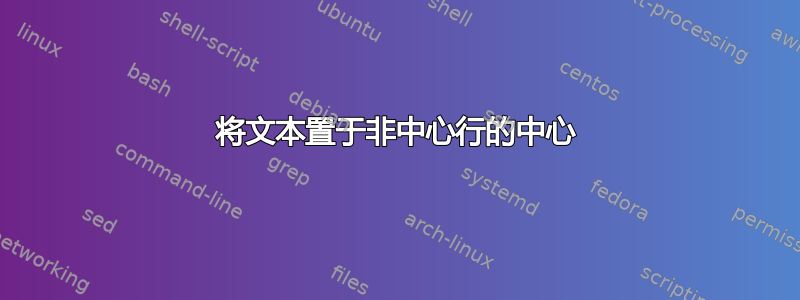
我需要一行包含三段文本的文本,分别向左对齐、向中间对齐和向右对齐,因此我尝试使用以下命令将它们分开\hfill:
\documentclass{article}
\usepackage{lipsum}
\begin{document}
\noindent foo\hfill foo\hfill foo
\noindent foobar foobar foobar foobar foobar foobar\hfill foo\hfill foo
\noindent\lipsum[1]
\end{document}
如果文本长度相同,则可行,但如果文本长度不同,则不行。我理解,这\hfill会将行中的空白空间划分为与命令给出的次数相同的部分,并将它们放置在命令本身给出的位置。这意味着中心文本位于左侧和右侧之间的空白空间中,但我希望它位于左侧和右侧边距之间的中心。
为了更清楚起见,这是我得到的结果:
这就是我想要的:
我怎样才能做到这一点?
答案1
据我所知,你可以认为的推力效应\hfill与具有无限可膨胀性的压缩机械弹簧的推力效应相同。只要我内化了这个类比,我就不会遇到概念错误的情况。
下图试图以示意图的方式说明这一类比。
\documentclass[12pt]{article}
\usepackage{tikz}
\usepackage{circledsteps}
\usepackage{adjustbox}
\usepackage{xsavebox}
\usetikzlibrary{arrows.meta, decorations.pathmorphing, tikzmark, calc}
\setlength\parindent{0pt}
\tikzset{
inline/.style = {
baseline, xshift=-2pt
},
inline insert/.style = {
overlay, inline
},
my mark/.style = {
green!40!black, thick
},
spring/.style = {
{|[width=1em]}-{|[width=1em]},
semithick,
orange!95!black,
/pgf/decoration/name=coil,
/pgf/decoration/aspect=-0.37,
/pgf/decoration/post length=0.4mm,
/pgf/decoration/pre length=0.7mm,
/pgf/decoration/amplitude=1.5mm,
/pgf/decoration/segment length=#1
},
force/.style = {
to path = {
decorate {([yshift=1.5mm]\tikztostart) -- ([yshift=1.5mm]\tikztotarget)}
},
execute at begin to = {
\begin{scope}[
overlay,
<-,
help lines,
draw=red!70!black,
shorten <= -2mm,
>=latex
]
\draw ([yshift=4.5mm]\tikztostart) -- ++ (#1,0);
\draw ([yshift=4.5mm]\tikztotarget) -- ++(-#1,0);
\end{scope}
}
}
}
\newcommand\Mybox[1]{%
\adjustbox{
padding*=0.2em 1em 0.2em 1em,
frame,
minipage=\linewidth,
margin*=0em 1em 0em 0em,
precode={\sffamily}{}
}{\sffamily\normalsize%
#1
}
}
\xsavebox{spring}{%
\begin{tikzpicture}
\draw[spring={0.9mm}, -, /pgf/decoration/post length=0.9mm, /pgf/decoration/pre length=1.5mm,
/pgf/decoration/aspect=-0.39,
decorate] (0,0) -- (0.8,0);
\end{tikzpicture}
}
\newcommand\Insert[1]{%
\tikz[inline insert]{\draw[my mark, <-<, >=Latex] (0,0) -- (0,2.5em) node[rotate=50, anchor=south west, inner sep=0pt] {#1};}%
}
\newcommand\InlineSpring[1]{%
\tikz{\draw[spring={#1}, force=0.3] (0,0) to (0.4,0)}%
}
\begin{document}
\small
\Mybox{foobar foobar foobar foobar foobar foobar \Insert{\ttfamily \textbackslash hfill}foo \Insert{\ttfamily \textbackslash hfill}foo}\bigskip\bigskip
\Mybox{foobar foobar foobar foobar foobar foobar \Insert{\Circled{\xusebox{spring}}}foo \Insert{\Circled{\xusebox{spring}}}foo}
Imagine \texttt{\textbackslash hfill} directives as compressed springs being placed between boxes.\par\bigskip
\Mybox{foobar foobar foobar foobar foobar foobar\InlineSpring{0.35mm}foo\InlineSpring{0.35mm}foo}
The springs expand until the left and rightmost glyphs are pushed against the page margins.\par\bigskip
\Mybox{foobar foobar foobar foobar foobar foobar\tikzmark{1-start}\hfill\tikzmark{1-end}foo\tikzmark{2-start}\hfill\tikzmark{2-end}foo}
\begin{tikzpicture}[overlay, remember picture]
\foreach \i in {1,2} {
\draw[spring={1.9mm}, force=0.17] (pic cs:\i-start) to (pic cs:\i-end);
}
\end{tikzpicture}
\end{document}





